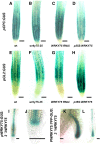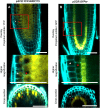Non-cell-autonomous regulation of root hair patterning genes by WRKY75 in Arabidopsis
- PMID: 24676857
- PMCID: PMC4012579
- DOI: 10.1104/pp.113.233775
Non-cell-autonomous regulation of root hair patterning genes by WRKY75 in Arabidopsis
Abstract
In Arabidopsis (Arabidopsis thaliana), root hairs are formed in cell files over the cleft of underlying cortex cells. This pattern is established by a well-known gene regulatory network of transcription factors. In this study, we show that WRKY75 suppresses root hair development in nonroot hair files and that it represses the expression of TRIPTYCHON and CAPRICE. The WRKY75 protein binds to the CAPRICE promoter in a yeast one-hybrid assay. Binding to the promoter fragment requires an intact WRKY protein-binding motif, the W box. A comparison of the spatial expression of WRKY75 and the localization of the WRKY75 protein revealed that WRKY75 is expressed in the pericycle and vascular tissue and that the WRKY75 RNA or protein moves into the epidermis.
Figures







Similar articles
-
ENHANCER of TRY and CPC 2 (ETC2) reveals redundancy in the region-specific control of trichome development of Arabidopsis.Plant Mol Biol. 2004 May;55(3):389-98. doi: 10.1007/s11103-004-0893-8. Plant Mol Biol. 2004. PMID: 15604688
-
Novel epidermal-cortical pattern and root apical silencing of VcCPC promoter activity in Arabidopsis might suggest a joint contribution to hairless roots in blueberry.BMC Plant Biol. 2025 May 24;25(1):694. doi: 10.1186/s12870-025-06744-y. BMC Plant Biol. 2025. PMID: 40413444 Free PMC article.
-
Negative feedback regulation of GLABRA1 contributes to epidermal cell patterning in the Arabidopsis root.Biochem Biophys Res Commun. 2024 Dec 10;737:150869. doi: 10.1016/j.bbrc.2024.150869. Epub 2024 Oct 26. Biochem Biophys Res Commun. 2024. PMID: 39489112
-
The gene regulatory network for root epidermal cell-type pattern formation in Arabidopsis.J Exp Bot. 2009;60(5):1515-21. doi: 10.1093/jxb/ern339. Epub 2009 Jan 27. J Exp Bot. 2009. PMID: 19174459 Free PMC article. Review.
-
Root layers: complex regulation of developmental patterning.Curr Opin Genet Dev. 2008 Aug;18(4):354-61. doi: 10.1016/j.gde.2008.05.001. Epub 2008 Jul 9. Curr Opin Genet Dev. 2008. PMID: 18617392 Free PMC article. Review.
Cited by
-
Identification of WRKY Gene Family from Dimocarpus longan and Its Expression Analysis during Flower Induction and Abiotic Stress Responses.Int J Mol Sci. 2018 Jul 25;19(8):2169. doi: 10.3390/ijms19082169. Int J Mol Sci. 2018. PMID: 30044387 Free PMC article.
-
FvWRKY50 is an important gene that regulates both vegetative growth and reproductive growth in strawberry.Hortic Res. 2023 May 31;10(7):uhad115. doi: 10.1093/hr/uhad115. eCollection 2023 Jul. Hortic Res. 2023. PMID: 37577404 Free PMC article.
-
AtWRKY75 positively regulates age-triggered leaf senescence through gibberellin pathway.Plant Divers. 2020 Nov 1;43(4):331-340. doi: 10.1016/j.pld.2020.10.002. eCollection 2021 Aug. Plant Divers. 2020. PMID: 34485776 Free PMC article.
-
Genome-wide analysis of adaptive molecular evolution in the carnivorous plant Utricularia gibba.Genome Biol Evol. 2015 Jan 9;7(2):444-56. doi: 10.1093/gbe/evu288. Genome Biol Evol. 2015. PMID: 25577200 Free PMC article.
-
Chromatin accessibility illuminates single-cell regulatory dynamics of rice root tips.BMC Biol. 2022 Dec 8;20(1):274. doi: 10.1186/s12915-022-01473-2. BMC Biol. 2022. PMID: 36482454 Free PMC article.
References
-
- Bernhardt C, Lee MM, Gonzalez A, Zhang F, Lloyd A, Schiefelbein J. (2003) The bHLH genes GLABRA3 (GL3) and ENHANCER OF GLABRA3 (EGL3) specify epidermal cell fate in the Arabidopsis root. Development 130: 6431–6439 - PubMed
-
- Bernhardt C, Zhao M, Gonzalez A, Lloyd A, Schiefelbein J. (2005) The bHLH genes GL3 and EGL3 participate in an intercellular regulatory circuit that controls cell patterning in the Arabidopsis root epidermis. Development 132: 291–298 - PubMed
-
- Birnbaum K, Shasha DE, Wang JY, Jung JW, Lambert GM, Galbraith DW, Benfey PN. (2003) A gene expression map of the Arabidopsis root. Science 302: 1956–1960 - PubMed
-
- Clough SJ, Bent AF. (1998) Floral dip: a simplified method for Agrobacterium-mediated transformation of Arabidopsis thaliana. Plant J 16: 735–743 - PubMed
Publication types
MeSH terms
Substances
LinkOut - more resources
Full Text Sources
Other Literature Sources
Molecular Biology Databases

